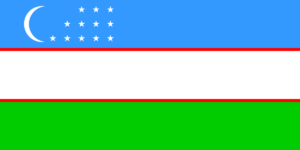Uzbekistan’s region has a lengthy and rich history. Numerous of its cities served as important commercial hubs along the renowned Silk Road. Because of its location in Central Asia, the region has seen numerous dynasties and conquerors pass through, including those led by Genghis Khan’s Mongols, the Arabs, Alexander the Great, and the Samanid Dynasty.
The Timurid dynasty, headed by Tamerlane, ascended to power in Uzbekistan in the fourteenth century. The majority of the area was covered by Tamerlane’s dominion, which was centered at Samarkand.
The Russian Empire incorporated Uzbekistan in the 1800s. Following the Soviet Union, the region was a part of the Russian Empire. Uzbekistan gained independence in 1991 following the dissolution of the Soviet Union.
| Capital | Tashkent (Toshkent) |
| Population | 35,263,799 (Source: 2023 worldometer) |
| Major Cities | Tashkent, Bukhara, Samarkand, Qarshi, Navoi, Andijan, Namangan, Nukus, Fergana |
| Borders | Kazakhstan to the northwest and north, Kyrgyzstan and Tajikistan to the east and southeast, Afghanistan to the south, and Turkmenistan to the southwest |
| Gross Domestic Product (GDP) | $80,391,853,885 (2022 worldometer) |
| Currency | Uzbekistani soum (UZS) |

Uzbekistan Major Industries: textiles, food processing, machine building, metallurgy, gold petroleum, natural gas, chemicals
Uzbekistan Agricultural Products: cotton, vegetables, fruits, grain; livestock
Uzbekistan Natural Resources: natural gas, petroleum, coal, gold, uranium, silver, copper, lead and zinc, tungsten, molybdenum
Uzbekistan Major Exports: cotton 41.5%, gold 9.6%, energy products 9.6%, mineral fertilizers, ferrous metals, textiles, food products, automobiles (1998)
Uzbekistan Major Imports: machinery and equipment 49.8%, foodstuffs 16.4%, chemicals, metals (1998)
Total Size of Uzbekistan: 331,690 km² (source: wikipedia)
Geographical Low Point of Uzbekistan: Sariqarnish Kuli -12 m
Geographical High Point of Uzbekistan: Adelunga Toghi 4,301 m
Climate of Uzbekistan: mostly midlatitude desert, long, hot summers, mild winters; semiarid grassland in east
General Terrain of Uzbekistan: mostly flat-to-rolling sandy desert with dunes; broad, flat intensely irrigated river valleys along course of Amu Darya, Syr Darya (Sirdaryo), and Zarafshon; Fergana Valley in east surrounded by mountainous Tajikistan and Kyrgyzstan; shrinking Aral Sea in west
World Region or Continent of Uzbekistan: Asia
Geographical Coordinates: 41 00 N, 64 00 E
Uzbekistan Government Type: republic; authoritarian presidential rule, with little power outside the executive branch
Uzbekistan Nationality: Uzbekistani
Uzbekistan National Holiday: Independence Day, 1 September (1991)
Uzbekistan Independence: 1 September 1991 (from Soviet Union)
Uzbekistan National Symbol: khumo (mythical bird)
Uzbekistan National Anthem or Song: O’zbekiston Respublikasining Davlat Madhiyasi (National Anthem of the Republic of Uzbekistan)
Uzbekistan Languages Spoken: Uzbek 74.3%, Russian 14.2%, Tajik 4.4%, other 7.1%
Uzbekistan Religions: Muslim 88% (mostly Sunnis), Eastern Orthodox 9%, other 3%
Republic of Uzbekistan is the nation’s official name.
It is renowned for the variety of architecture and the abundance of museums.
The most literate nation is Uzbekistan.
The Uzbek flag, which features four colors, a crescent moon, and 12 stars, has a deep symbolic value.
The colors of the flag are blue for the sky, white for purity and peace, and green for Islam and the natural world.
The flag’s crescent moon and 12 stars stand for Islam and the 12 months of the Islamic calendar, respectively.
The majority of people in the nation are Muslims (about 90%); other religions include Russian Orthodox, Christianity, Judaism, and Zoroastrianism.
A country with two landlocked borders is Uzbekistan.
Only men are permitted to shake hands.
You must bow to a woman and place your hand over your heart when you welcome her.
At 15,233 feet above sea level, Khazret Sultan is Uzbekistan’s highest point.
There are 2 national parks and 9 natural reserves in Uzbekistan.
There are 5 UNESCO World Heritage Sites in Uzbekistan.
The production of commodities including cotton, gold, uranium, and natural gas is the mainstay of Uzbek economy.
Plov, the country’s national cuisine, is a main course comprised of rice, chunks of meat, carrots, and onions.
The national beverage of Uzbekistan is green tea, which is consumed all day long.
Most people in Uzbekistan consume vodka, which is a well-liked beverage.
Either the state controls all media in Uzbekistan, or none at all. There is no such thing as press freedom.
According to Uzbek custom, the valued guest is seated the furthest away from the home’s door.
The major pursuits you can partake in in Uzbekistan are rafting, hiking, bird watching, and camel trekking.

